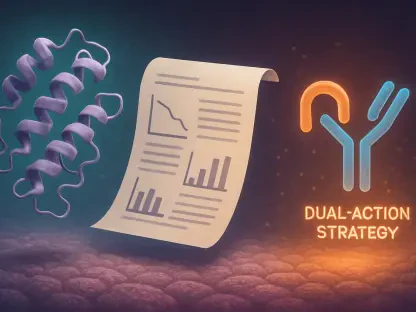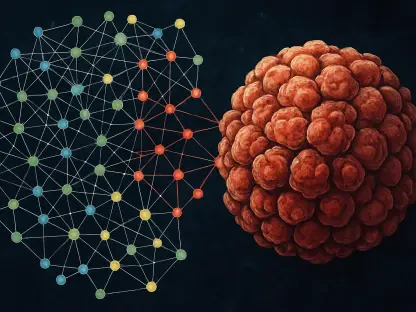Imagine a diagnosis of advanced kidney cancer, a condition once considered a near-certain death sentence due to limited treatment options, but today, groundbreaking research has shifted this narrative, offering renewed hope to thousands of patients worldwide. The focus of this progress lies in a pioneering two-drug combination therapy that has demonstrated remarkable success in extending survival for those with advanced clear cell renal cell carcinoma (ccRCC), the most common type of kidney cancer. This FAQ article aims to address critical questions surrounding this innovative treatment, providing clear insights into its benefits, mechanisms, and future potential. Readers can expect to explore the therapy’s impact, supported by clinical trial data, and learn about ongoing efforts to refine patient care through emerging research.
The scope of this discussion encompasses the specifics of the therapy, its comparison to traditional treatments, and the challenges still ahead in optimizing outcomes. By breaking down complex concepts into accessible answers, this article seeks to inform patients, caregivers, and anyone interested in the evolving landscape of cancer treatment. Each section addresses a unique aspect of this medical advancement, ensuring a comprehensive understanding of its significance in modern oncology.
Key Questions or Key Topics
What Is the Two-Drug Combination Therapy for Advanced Kidney Cancer?
The two-drug combination therapy involves pembrolizumab, an immunotherapy that inhibits PD-1 to enhance the immune system’s ability to fight cancer, paired with axitinib, an antiangiogenic drug that targets VEGF receptors to block tumor blood vessel growth. This dual approach is significant because it addresses cancer through two distinct mechanisms, unlike older single-drug therapies that often yielded limited success. For patients with advanced ccRCC, this represents a transformative option, especially as a first-line treatment for those newly diagnosed with the condition.
This combination was designed to tackle the aggressive nature of advanced kidney cancer, which historically has poor survival rates due to rapid progression and resistance to conventional treatments. By combining immunotherapy with a drug that disrupts tumor blood supply, the therapy offers a synergistic effect, enhancing the body’s natural defenses while directly attacking the cancer’s growth infrastructure. The importance of this strategy lies in its ability to provide a more robust and sustained response compared to previous standards of care.
Clinical trial data supports the efficacy of this approach, showing a marked improvement in patient outcomes over a follow-up period of several years. The therapy not only extends life expectancy but also improves the likelihood of tumor reduction, offering a lifeline to those facing a challenging prognosis. This dual mechanism continues to redefine treatment protocols in oncology, setting a new benchmark for managing advanced cancers.
How Does This Therapy Compare to Traditional Treatments?
When compared to sunitinib, a single-drug therapy long used as a standard treatment for advanced ccRCC, the two-drug combination of pembrolizumab and axitinib demonstrates superior results. Traditional treatments like sunitinib primarily focus on inhibiting tumor blood vessel growth but often fall short in providing long-term control over cancer progression. In contrast, the combination therapy leverages both immune activation and vascular disruption, addressing multiple pathways of cancer development.
The difference in outcomes is striking, with clinical trials revealing that the combination therapy extends overall survival to a median of 47.2 months compared to 40.8 months with sunitinib. Additionally, progression-free survival, which measures the time before the cancer worsens, stands at 15.7 months for the dual therapy versus 11.1 months for the single-drug option. These figures highlight a clear advantage, making the newer approach a preferred choice for many clinicians and patients.
Moreover, the objective response rate, which indicates the percentage of patients whose tumors shrink or disappear, is significantly higher at 60.6% for the combination compared to 39.6% for sunitinib. This data underscores the therapy’s ability to achieve more substantial tumor control, offering not just longer survival but also a better quality of response. Such evidence has cemented the dual therapy’s role as a leading first-line treatment in current medical practice.
What Are the Long-Term Benefits of This Combination Therapy?
Long-term follow-up from clinical trials, extending over five years, confirms the durability of benefits provided by the pembrolizumab and axitinib combination. This extended evaluation is crucial because advanced kidney cancer often recurs or progresses despite initial treatment success. The sustained improvement in survival and response rates indicates that the therapy does not merely delay progression but offers a lasting impact for many patients.
One of the standout benefits is the consistency of survival gains, with patients on the combination therapy experiencing a meaningful extension of life compared to those on traditional treatments. This durability translates into more time for patients to live with their families, pursue personal goals, or engage in daily activities, which is a profound shift from the historical outlook for this disease. The therapy’s ability to maintain effectiveness over years sets it apart as a cornerstone of modern cancer care.
Beyond survival, the long-term data also shows a higher proportion of patients achieving tumor reduction or stabilization, which can significantly improve quality of life. While not all patients respond equally, the overall trend points to a reliable option for managing a disease that once had few effective solutions. This enduring benefit continues to shape treatment guidelines and inspire confidence in the approach among healthcare providers.
Can Biomarkers Predict Who Will Benefit Most from This Therapy?
Research into biomarkers—biological indicators that could predict treatment response—remains an active area of exploration for optimizing the use of the two-drug combination. Various markers, such as an 18-gene T-cell-inflamed expression profile, angiogenesis signatures, and PD-1 ligand expression, have been studied to identify which patients are most likely to benefit from either the combination therapy or alternative treatments. The goal is to personalize care, ensuring that therapies are matched to individual patient profiles.
While some RNA signatures show promise in distinguishing potential responders, experts caution that these findings are not yet conclusive. The challenge lies in validating these biomarkers through prospective studies to ensure their reliability in clinical settings. Without definitive predictors, the therapy is currently recommended for all patients with advanced ccRCC, regardless of specific biological markers, to maximize access to its benefits.
The pursuit of reliable biomarkers reflects a broader trend in oncology toward precision medicine, where treatments are tailored to genetic or molecular characteristics. Although this aspect of research is still evolving, it holds the potential to refine treatment decisions in the coming years, possibly through 2027, as further studies build on these initial insights. Until then, the focus remains on ensuring broad application of the therapy while continuing to investigate predictive tools.
What Challenges Remain in Advancing Kidney Cancer Treatment?
Despite the success of the two-drug combination, several challenges persist in the field of kidney cancer treatment. One primary issue is the variability in patient response, as not everyone achieves the same level of benefit from the therapy. Understanding why some individuals respond better than others is a critical question that researchers are working to address through ongoing studies and clinical trials.
Another hurdle is the need for validated biomarkers to guide treatment selection, as current options lack the precision needed for personalized care. This gap limits the ability to tailor therapies effectively, sometimes resulting in trial-and-error approaches that can delay optimal treatment. Addressing this requires significant investment in research and collaboration across medical and scientific communities to develop actionable tools.
Additionally, managing side effects and long-term tolerability of combination therapies poses an ongoing concern. While the dual therapy offers substantial benefits, balancing efficacy with patient comfort and safety remains a priority. Future advancements will likely focus on minimizing adverse effects while maintaining or even enhancing the therapy’s impact, ensuring that progress continues to improve patient outcomes.
Summary or Recap
This discussion highlights the transformative role of the pembrolizumab and axitinib combination in treating advanced clear cell renal cell carcinoma, showcasing its superiority over traditional single-drug therapies like sunitinib. Key points include the therapy’s ability to extend overall survival, improve progression-free survival, and achieve higher response rates, as evidenced by long-term clinical trial data. The exploration of biomarkers also emerges as a promising avenue, though further validation is needed to personalize treatment effectively.
The main takeaway is that this two-drug approach marks a significant leap forward in kidney cancer care, offering durable benefits and reshaping treatment standards. Challenges such as variable patient responses and the absence of definitive predictive tools underscore the importance of continued research. For those seeking deeper knowledge, exploring resources from reputable oncology organizations or clinical trial databases can provide additional insights into emerging therapies and studies.
Conclusion or Final Thoughts
Reflecting on the advancements discussed, it becomes clear that the journey of improving kidney cancer treatment has reached a pivotal moment with the success of the two-drug combination. This breakthrough has not only extended lives but also opened doors to new possibilities in patient care. The focus has shifted from mere survival to enhancing the quality of response and longevity of outcomes.
Looking ahead, the next steps involve accelerating research into biomarkers to ensure treatments can be tailored more precisely to individual needs. Patients and caregivers are encouraged to discuss these options with healthcare providers, exploring how emerging therapies might align with specific medical circumstances. Staying informed about ongoing trials and innovations remains a vital action to leverage the full potential of these medical strides.
Ultimately, the progress made has laid a strong foundation for future developments, urging all stakeholders to remain engaged in the evolving landscape of oncology. Considering how these advancements could impact personal health decisions or support systems for loved ones is a meaningful way to connect with this transformative era in cancer treatment.









